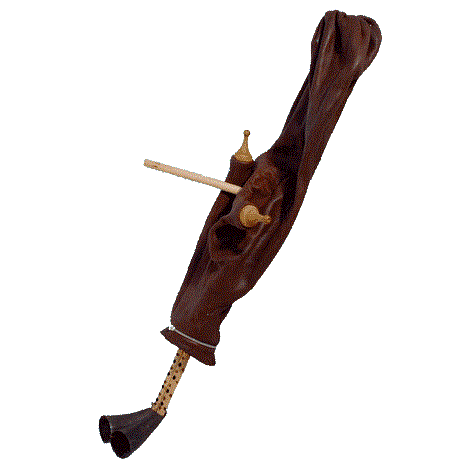Mizwid
Woodwinds
Africa
Between 1001 and 1900 AD
Video
The mizwid, also known as mezoued or mizwad, is a traditional North African bagpipe predominantly played in Tunisia and parts of Algeria. The term “mizwid” derives from the Arabic word for “sack” or “bag,” reflecting its construction and function. This instrument holds a significant place in the musical heritage of the region, symbolizing cultural identity and social traditions.
Construction and Design
The mizwid is crafted from natural materials, emphasizing its deep connection to the environment and traditional craftsmanship. The primary components include:
-
Bag: Made from ewe’s leather, the bag serves as a reservoir for air. The use of natural leather ensures flexibility and durability, essential for maintaining consistent air pressure during play.
-
Double Chanter: Attached to the bag is a double-chanter, typically constructed from river reeds. Each chanter features multiple finger holes, allowing the musician to produce a range of melodies. The chanters terminate in cow horns, which amplify the sound and add a distinctive tonal quality.
-
Blowpipe: A blowpipe is used to inflate the bag. The musician blows air into the bag through this pipe, enabling continuous play without the need for frequent breaths.
The meticulous assembly of these components results in an instrument capable of producing a powerful and distinctive sound, characterized by its rich, resonant tones.
Historical Context and Evolution
The origins of the mizwid can be traced back to the early 20th century in Tunisia. Initially, it was associated with rural communities and the working class, often featured in local festivities and ceremonies. Over time, the mizwid transcended its humble beginnings, gaining prominence in urban centers and becoming a symbol of national identity.
Despite facing periods of decline, particularly during times when traditional music was overshadowed by modern genres, the mizwid has experienced a resurgence. Contemporary musicians have embraced the instrument, integrating its unique sound into various musical styles, including hip-hop and jazz, thereby introducing it to new audiences and ensuring its continued relevance.
Cultural Significance
The mizwid is more than a musical instrument; it is a cultural emblem deeply ingrained in the social fabric of Tunisia. Traditionally, it accompanies celebrations such as weddings and formal gatherings, where its music is believed to induce a trance-like state among participants, facilitating communal bonding and spiritual expression.
The instrument’s association with the darbouka, a type of North African drum, further enriches its role in traditional ensembles. This combination creates a rhythmic and melodic foundation that is quintessential to Tunisian folk music.
Construction Process
Crafting a mizwid is an art form that requires skill and an understanding of natural materials. The process begins with selecting high-quality ewe’s leather for the bag, ensuring it is properly treated to maintain airtightness and flexibility. The double chanters are carefully fashioned from river reeds, with precise measurements to ensure accurate pitch and tone. The cow horns are cleaned and polished before being attached to the chanters, serving both aesthetic and acoustic functions.
Artisans often personalize the mizwid with decorative elements, reflecting regional styles and individual craftsmanship. This personalization not only enhances the visual appeal of the instrument but also signifies the cultural identity of the maker and player.
Playing Technique
Mastering the mizwid requires dedication and practice. Musicians employ a technique known as circular breathing, which allows for continuous sound production. This involves inhaling through the nose while simultaneously pushing air out of the bag using arm pressure, enabling the player to maintain a steady tone without interruption.
The double chanters provide a harmonic structure, with each pipe capable of producing different notes. By manipulating the finger holes, the musician can create complex melodies and harmonies, resulting in the characteristic sound of the mizwid.
Contemporary Adaptations
In recent years, the mizwid has found a place in various modern musical genres. Artists have experimented with its sound, blending it with electronic music, hip-hop, and jazz, thereby reaching a broader audience. This fusion has not only revitalized interest in the mizwid but also showcased its versatility as an instrument capable of transcending traditional boundaries.
Educational institutions and cultural organizations have also played a role in preserving and promoting the mizwid. Workshops, performances, and exhibitions have been organized to educate the public about its history, construction, and musical capabilities, ensuring that this traditional instrument continues to be appreciated by future generations.
The mizwid stands as a testament to Tunisia’s rich musical heritage. Its distinctive sound, cultural significance, and adaptability have allowed it to endure through changing times. As both a symbol of tradition and a vehicle for contemporary expression, the mizwid continues to captivate audiences, embodying the enduring spirit of Tunisian music.
FAQ
What type of musical instrument is the Mizwid?
The Mizwid is a traditional North African wind instrument, specifically a type of bagpipe. It consists of a double-reed chanter and a leather bag, used primarily in Tunisia and Libya. The instrument is known for its deep, resonant sound. It is commonly played in folk and ceremonial music.
How is the Mizwid used in music?
The Mizwid is played by inflating the leather bag and using arm pressure to produce continuous sound. Musicians use it for solo performances, traditional dance accompaniments, and festive gatherings. It is often played in weddings, cultural events, and Sufi ceremonies. The instrument's drone-like sound creates a mesmerizing effect.
What genres of music feature the Mizwid?
The Mizwid is primarily used in folk and traditional Tunisian music. It plays a significant role in Mezwed, a popular Tunisian genre characterized by rhythmic drumming and strong melodies. It is also featured in Sufi music and ceremonial performances. Its distinctive sound adds depth to cultural expressions.
 Links
Links
References
- Mizwad - Wikipedia
- Tunisia 'Mizwad' - Hartenberger World Musical Instrument Collection
- Zukra | Northern African | The Metropolitan Museum of Art
- The mizwid in Tunisia: a well-known musical instrument
- Traditional Tunisian bagpipes make a comeback | Africanews
- New life breathed into Tunisia's bagpipes - Al-Monitor</a ::contentReference[oaicite:0]{index=0}
Other Instrument
Categories


















